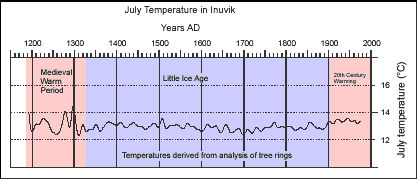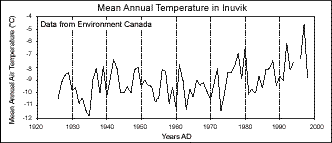| ||||||||||||||||||||||||||||
Proactive disclosure Print version |  Taking the Chill Off: Climate Change in the Yukon and Northwest Territories How has the climate changed?  Folland, C.K., Karl, T.R. and Vinnikov, K.Y., 1990. Observed climate variations and change; in Climate Change: the IPCC Scientific Assessment The earth's climate has always changed. During the last ice age, glaciers covered much of Canada and temperatures were much colder than today in the Arctic. Rapid warming followed the ice age and global temperatures were 2°C warmer than in the early 20th century.  Begin, C., Michaud, Y. and Archambault, S. 2000, Tree-ring evidence of recent climate changes in the Mackenzie Basin Northwest Territories, Canada; in The physical environment of the Mackenzie Valley, Northwest Territories; a baseline for the assessment of environmental change, L.D. Dyke and G.R. Brooks (eds.); Geological Survey of Canada Bulletin 547, 212 p  Data from Inuvik shows that air temperatures have also changed over the last 800 years. During the Medieval Warm Period (1200 to 1300 AD), temperatures were higher than today. A cool period called the Little Ice Age followed this, ending only about 100 years ago. Warming has generally occurred over the last 100 years with average annual air temperatures for the western Arctic increasing by 1.5°C. Why Does the Climate Change? Major shifts in climate, such as those that resulted in past ice ages, are related to changes in the Earth's position relative to the sun. Shorter term changes in climate can occur after major volcanic eruptions. Following the eruption of Mount Pinatubo in the Philippines in 1991, temperatures were cooler than normal for a few years. Changes in the circulation and temperature of the oceans can also cause shifts in climate such as El Niño events. Such an event occurred in 1997-1998 and average annual temperatures in the western Arctic were almost 4°C warmer than normal. What is the Greenhouse Effect? About half of the energy the Earth receives from the sun is absorbed by the earth's surface. Longwave or infrared energy is emitted by the Earth and while some of this energy passes directly through the atmosphere, the rest is absorbed by gases such as carbon dioxide (CO2) and water vapour. This effect, called the greenhouse effect, keeps the Earth's surface and atmosphere from cooling too quickly at night when the sun is no longer shining. This effect is necessary to maintain the range of temperatures required to support life on the Earth's surface.   Hegeveld, H., 1995. Understanding atmospheric change. Environment Canada SOE Report No. 95-2, 68 p. As the atmospheric concentration of greenhouse gases such as carbon dioxide increases due to the burning of fossil fuels for example, the greenhouse effect is enhanced. The loss of heat from the Earth's surface and lower atmosphere occurs at a lower rate and this leads to an increase in global air temperatures. How might the climate change?
Scientists use models called General Circulation Models (GCM) to predict future climate. The map to the left shows how much warmer average annual air temperatures are expected to be in the middle of the 21st century compared to those in the last 30 years of the 20th century. The Canadian Climate Centre model predicts that average air temperatures in the western Arctic will be between 2 and 5°C higher.
|